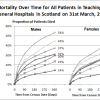
Some time ago a colleague of mine in Ireland, Eugene Murray, then CEO of the Irish Hospice Foundation, raised the idea of whether it was possible to work out what proportion of people in hospital at any one time are in the last year of life. Knowing the figure, he argued, would assist in advocacy for those patients, raise awareness in clinicians and perhaps stimulate more effort to make appropriate care plans for people who might benefit.
Recently, we have been able to take this idea forward using techniques of record linkage (‘big data’ in the current jargon) that have enabled us to connect hospital records to death registrations for all the people in hospital in Scotland on a single day – 31 March 2010.
The full results of our study can be found at: Clark, D Armstrong, M Allan, A, Graham, F Carnon, A Isles, C. Imminence of death among hospital inpatients: a prevalent cohort study. Palliative Medicine March 2014, online first.
The study
Most efforts to identify the proportion of people in hospital who are in the last year of life have been based on local studies done in one or two settings, using small samples. We wanted to look not at a sample of hospital patients, but at an entire population of those hospitalised in one country on a given date. We therefore set out to establish the likelihood of death within 12 months of a cohort of all hospital inpatients in Scotland on a fixed ‘census’ date. This type of approach is known as a prevalent cohort study. We were fortunate in attempting it to have the assistance of Matthew Armstrong of the Healthcare Information Group, at NHS National Services Scotland who was able to link hospital records with death registrations.
What we found
Our census identified 10,743 inpatients in 25 Scottish teaching and general hospitals on 31 March 2010 (we excluded cottage and community hospitals and long stay facilities). We found that 3,098 (28.8%) patients died during the one year follow up period: 2.9% by 7 days, 8.9% by 30 days, 16.0% by 3 months, 21.2% by 6 months, 25.5% by 9 months and 28.8% by 12 months.
The likelihood of dying rose steeply with age and was three times higher at one year for patients aged 85 and over, compared to those who were under 60. Men were more likely to die than women.
A striking finding was that almost one in ten patients (9.3%) of patients died during the admission on which we recorded them – and this accounted for 32.3% of all the deaths within the 12 month follow-up period.
Implications
Our study has quantified for the first time the large number of hospital patients – at any one time – that are within the last year of life and clearly has implications for health care priority setting. Our findings support the various initiatives currently underway to raise the profile of end of life care in hospitals, and where it is known there are still difficulties in making the transition to palliative care and in implementing interventions for the imminently dying. We show that so-called ‘acute’ hospital services are in fact dealing with a very large number of people who are nearing the end of their lives – though they may not always acknowledge that.
In order that appropriate care plans can be made and delivered, we believe there is a strong need for hospitals to adopt a more vigorous approach to identifying patients who are entering the last year of their lives. We argue from our findings that the culture and organization of hospitals need to become more attuned to the high proportion of inpatients in imminent need of end of life care. We are hoping to develop further work on how this can be done.
David Clark


Dear Prof Clark,
I found the study very interesting and although it is not my sector, I would like to know whether you have the family composition of the patients identified in the study. My reason was to see whether there is a link between people being cared for by non family members and the mortality rate. The bigger pricture would be to see if non health related issues and after hospital care affect survival rates.
There is a chance of course that my questions show my ignorance on the topic so feel free to ignore them!
Regards,
Evi
Am happy wth ths article as am a medical student doing a research on palliative care in a certain hospital in Kenya i kindly request if u have any materials about africa concerning the same
Thank you for this. Ours was the first study of its kind to be conducted, so I am not aware of any similar work in Africa. The simplest way forward would be to try to do the study not in a whole country, but in one hospital. David Clark
[…] our own study of the Imminence of Death among Hospital Inpatients, we showed that almost 1 in 10 patients in hospital on any given day in Scotland will die on that […]
[…] communications team and the journal had produced a plan to publicise the paper. I had prepared a blog post and my Twitter thumb was at the ready on publication day. The reported study had been complex to […]